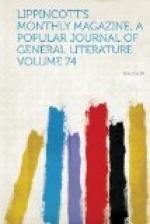It is one o’clock in the morning when we leave this scene, and the place is in full blast. Crossing the Chateau d’Eau, we plunge into a quiet street, down which comes a flood of light from an electric lamp hung before the entrance of the Tivoli Waux-Hall. Within, the ball-room is thronged. An occasional blouse is visible, but the blousard who comes here is generally arrayed in some fancy costume, which he hires for the night for a trifling sum or has devised in his leisure moments from odds and ends gathered in an old-clo’ market. There is a group of four now prancing in a quadrille, who are blousards enjoying at once their hours of ease and of triumph. Emulous of the “artists” of grander balls, they have got themselves up in the guise of American Indians, and are a sight to behold. Their faces are painted every color of the rainbow; and when I say painted I do not mean tricked out with the red and white of toilet-boxes, but daubed thickly with the kind of paint used in painting houses and signs—paint which stays in spite of the reeking perspiration which trickles off their cheeks. They wear no masks, but have pasteboard noses stuck upon their faces with glue, for they are “got up” for all night, and this is the proud scene on which they win laurels. Their dance is a coarse imitation of the gyrations of the professional cancanists, and they prance and cavort with glowing enthusiasm, happy in the evident admiration of a surrounding throng of provincials, pickpockets and prostitutes.
For a more genuine scene of blousard gayety come with me to the Rue Mouffetard, where there is a ball frequented solely by the lowest and poorest class of Paris strugglers for bread, such as the ragpickers and the street-sweepers. At first thought it seems improbable that the squalid wretches who can barely earn sous enough to live on, to whom fifty cents a day are fine wages, should have a ball. But all things are possible in Paris in the way of popular amusements. In the Rue Mouffetard, then, near the Rue Pot de Fer, we read on the wall of a gloomy building a yellow advertisement which is translatable thus, literally:
GREAT HALL OF THE OLD OAK.
MOUFFETARD STREET, 69, HOUSE OF LACROSSE,
All the Sundays, departing
from the first January, up till
Fat Tuesday.
BALL OF NIGHT!
DRESS, MASK, DISGUISE.
A Grand Orchestra, composed of Artists of Talent, will be conducted by G. Maurage, who will have performed a Repertory entirely new, composed of Quadrilles, Valses, Polkas, Schottisches, Varsoviennes, Mazurkas, Redowas, Lancers, etc.
ENTRANCE—On the
Sundays, five cents; at ordinary times, four
cents. One commences
at 8 o’clock.




